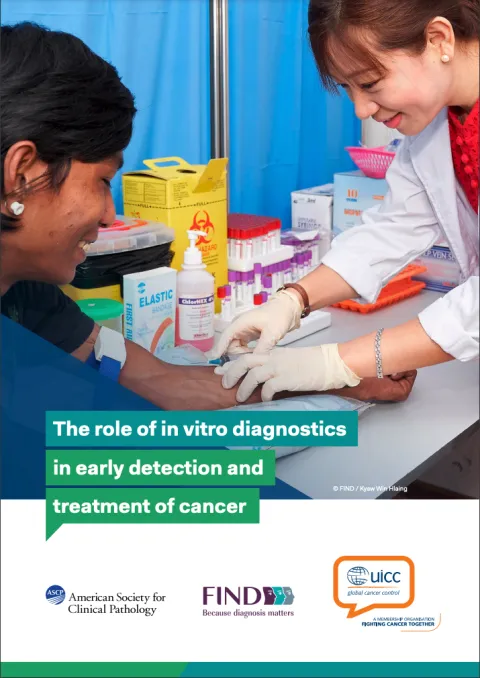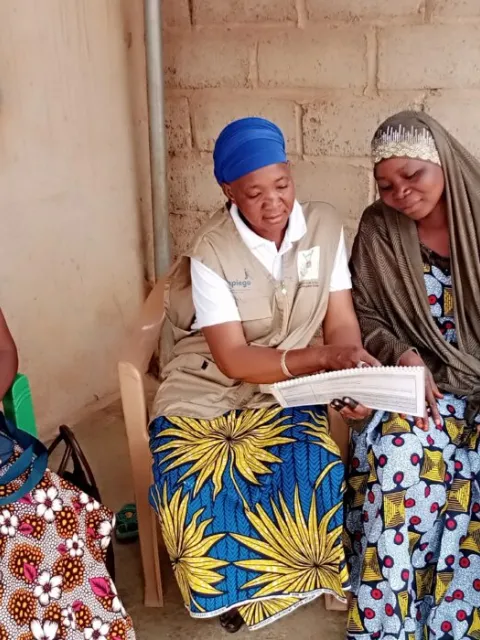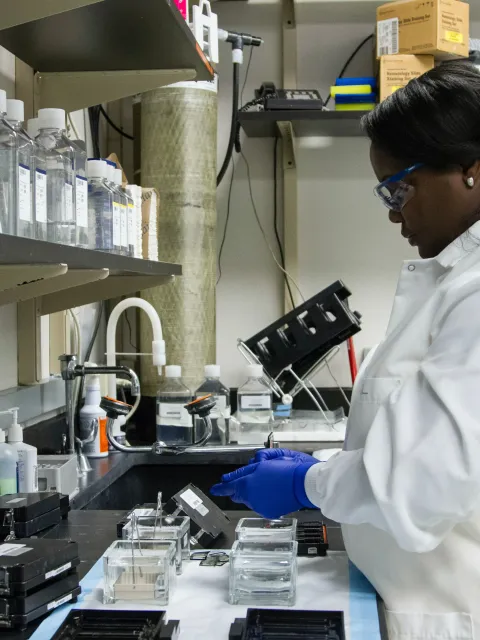In vitro diagnostics and the promise of better cancer survival rates
In vitro diagnostics offer the opportunity to detect cancer early, for more effective and timely treatment. These quality-assured diagnostics must be available to all those who need them, including in LMICs, for a “fairer, healthier world”.


The Union for International Cancer Control (UICC), in collaboration with the American Society for Clinical Pathology (ASCP) and the Foundation for Innovative New Diagnostics (FIND), have launched a report on “The role of in vitro diagnostics in early detection and treatment of cancer”.
The report highlights the role of in vitro diagnostics or IVDs in early detection of disease, explores the barriers to accessing IVDs, particularly in low- and middle-income countries (LMICs) and outlines ways to address them. The release of the report marks the occasion of World Health Day on 7th April, and is in line with the 2021 theme to “build a fairer, healthier world”.
Access to IVDs certainly holds the promise of a healthier future for many people diagnosed with cancer. Blood or tissue samples are taken from the individual and analysed in vitro (from the Latin “in the glass”) or outside the person’s body. These tests provide essential data that guide medical practitioners in the screening, diagnosis and treatment of cancer, with the aim of detecting the disease as early as possible, since the earlier a cancer is detected, generally the higher the chance is for a better treatment outcome. IVDs can also help determine whether a person presents a risk or predisposition for developing a certain type of cancer.
“30% of cancers are preventable and 30% could be screened for, so with perfect prevention and perfect screening, there would still be 40% left that we would like to detect as early as possible. Since prevention and screening are not perfect, this is where advanced IVDs come into play – and what I think we are trying to do is push back the moment of detection before patients have any clinical symptoms or any signs of tumour, so we can intervene and treat it as early as possible. This is particularly important in the case of aggressive tumours.”
– Dr Dan Milner, Chief Medical Officer at ASCP and co-author of “The role of in vitro diagnostics in early detection and treatment of cancer”
Furthermore, advances in IVDs not only promise better outcomes for people living with cancer, but also the cost of treatment is reduced, with substantial savings to health systems. “Total economic savings from an effective prevention, early detection and treatment strategy for breast cancer, versus a treatment-only approach, have been estimated at roughly 60% across all world regions," according to the report.
For this reason, Shalini Jayasekar Zürn, Senior Advocacy Manager at UICC and co-author of the report on IVDs, says that “countries should give critical consideration to the access, availability, and affordability of means to detect, diagnose and treat cancers. Furthermore, selection of IVDs should be based on national need, consideration for current testing capacity and available resources, and alignment with the National Essential Medicines list (NEML).”
Challenges to the equitable access of IVDs
To enable countries to develop cost-effective measures and for the global community to achieve the objective of not only a healthier but also a fairer world, IVDs need to be made more accessible in low-resource settings. Late-stage cancer diagnosis leading to lower survival rates is more prevalent in LMICs for a number of reasons, personnel and training needs, the cost of diagnostic tests and infrastructure requirements.
“The vision of the report was also to make the case for strengthening in vitro diagnostics and removing the barriers to access them, in order to find those people who have cancer but are not showing symptoms.”
– Dr Beatrice Vetter, Scientific Officer, FIND and co-author of “The role of in vitro diagnostics in early detection and treatment of cancer”
Specific barriers to accessing IVDs highlighted in the report include difficulties for patients to access health services, regulatory challenges, quality standards and supply chain issues, cost, infrastructure concerns and workforce and equipment shortages.
Difficulties in accessing services are not necessarily due only to the absence of adequate care centres. The number of facilities offering cancer care may also be limited and concentrated in urban centres. Depending on where a person lives, considerable time and expense commitment may be required to travel there and stay for care. And, of course, the cost of tests and treatment also represent significant barriers, which means patients cannot afford them but also physicians may conduct fewer or less complex diagnostics to preserve limited financial resources for treatment expenses.
IVDs also face complex regulatory pathways, which can be less developed than other medical products, such as medicines and vaccines, for which regulatory pathways may already be established. IVD developers are increasingly required to register their products locally, each time facing different standards and processes.
One recommendation of the IVD report is to widen the scope of the WHO prequalification (PQ) programme to cancer IVDs, which then facilitates access to IVDs that meet unified standards of quality, safety and efficacy with a specific focus on LMIC populations. It also calls on governments to streamline the requirements for registering emerging technologies that promise to considerably reduce the cancer burden.
Building a fairer, healthier world and the future of IVDs
According to the IVD report, there have been major advances in technology, immunochemistry and molecular testing in the recent past. These have led to the development of accurate and somewhat less expensive IVDs, including at point-of-care and self-sampling, which provide an opportunity for LMICs to move towards more precise diagnostics for cancer.
Innovative IVD design, such as self-sampling kits for testing for the human papillomavirus (HPV) that is the primary cause of cervical cancer, can help overcome issues of accessing quality care.
“Women can get self-sampling kits sent to their homes or can pick them up at community centres and send them back in for analysis, effectively decentralising care. Since women self-sample in the privacy of their homes, they are also not exposed to the stigma, embarrassment or fear of going to the doctor, which can constitute further barriers to accessing life-saving diagnostics services.”
– Dr Beatrice Vetter, Scientific Officer, FIND and co-author of “The role of in vitro diagnostics in early detection and treatment of cancer”
While there are fears that technological developments can widen the equity gap in quality care between low- and high-resource settings, Dan Milner is careful to point out that innovations that may not noticeably improve health outcomes in high-income countries could actually lead to substantial gains in LMICs.
An example of disruptive innovation in IVDs for LMICs is the Cepheid GeneXpert BreastStat4 cartridge for breast cancer screening, a point-of-care rapid test whereby patients would no longer need to travel to urban care centres. Not only are the total costs much lower than for traditional breast cancer testing, but when such a tool and the associated diagnostics services can be deployed broadly, women with breast masses can be seen and started on treatment within a few hours in their own village.
“There are new tools being created and marketed using simple, relatively low-cost approaches, in ways that should decrease not increase the technological gap. And we are having conversations with companies in HICs that are developing new tools around screening and precision medicine and asking them how they can make them more affordable and more accessible to other countries where they would have a far more measurable impact on patients’ health.”
– Dr Dan Milner, Chief Medical Officer at ASCP and co-author of “The role of in vitro diagnostics in early detection and treatment of cancer”
Other initiatives beyond innovation are helping to overcome the difficulties of accessing care. There have been substantial global investments to build laboratory infrastructure in LMICs and initiatives to integrate cancer prevention services with other health service delivery platforms such as HIV.
In its concluding messages, the IVD report emphasises prioritising essential IVDs based on national needs and capacity for treatment and must be aligned with the national essential medicines list.
The central idea is that, to ensure that LMICs also benefit from emerging IVD technologies and other health innovations, the barriers to access with respect to cost, supply chains, qualified personnel and regulation are all interconnected and must be addressed step-by-step but comprehensively. The health benefits promise to be transformative.
"As a UICC partner and the sponsor of this report, we are excited to see the official release of this report on the occasion of World Health Day. As this report addresses the global inequality in access to necessary cancer care, especially on access to IVDs emphasizing their role in the early detection of cancer, we hope that this report will help towards a worldwide effort to recognise the growing importance of selecting high-quality, affordable IVDs and its implementation, thus leading to better treatment. We would also like to take this opportunity to thank UICC, FIND and ASCP for their commitment to this report."
– Mrs. Choi, Eun-Jong, CEO of CUBEBIO, Seoul, South Korea
Last update
Thursday 01 December 2022
